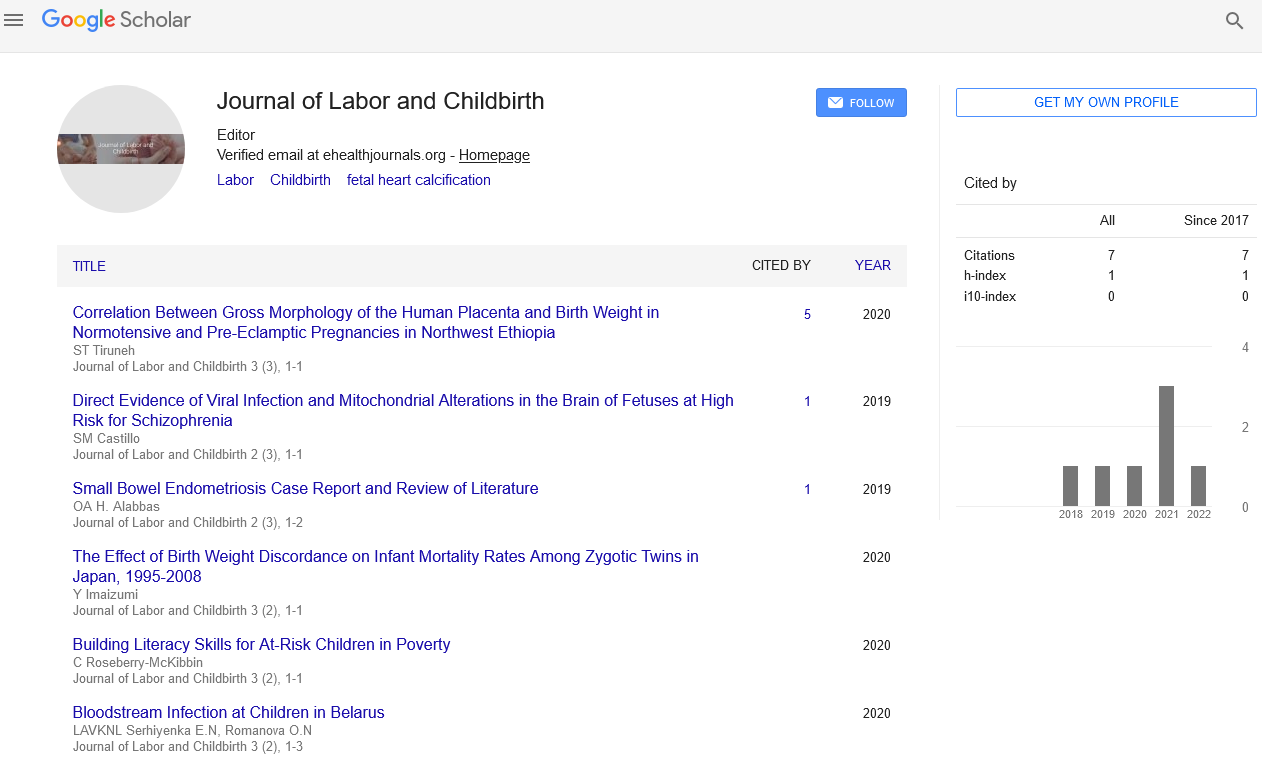Perspective - Journal of Labor and Childbirth (2023) Volume 6, Issue 5
Congenital Disorders: Causes, Types and Management
- Corresponding Author:
- William Gilbert
Department of Gynecology,
Ray University,
York,
United Kingdom
E-mail: gilbert@edu.in
Received: 04-Sep-2023, Manuscript No. jlcb-23-119514; Editor assigned: 07-Sep-2023, PreQC No. jlcb-23-119514 (PQ); Reviewed: 21- Sep-2023, QC No. jlcb-23-119514; Revised: 03-Oct-2023, Manuscript No. jlcb-23-119514 (R); Published: 31-Oct-2023, DOI: 10.37532/ jlcb.2023.6(5).151-153
Introduction
Congenital disorders, also known as congenital anomalies or birth defects, are conditions that occur before or at the time of birth. These disorders can affect various organs or systems in the human body and may lead to lifelong health challenges. Congenital disorders can range from mild to severe and they may have a genetic, environmental or multifactorial origin. This article aims to provide a comprehensive overview of congenital disorders, including their causes, types, diagnosis and management.
Description
Causes of congenital disorders
Genetic factors: The two most common genetic causes of congenital anomalies are single-gene defects and chromosomal abnormalities.
Single-gene mutations
Some congenital disorders result from mutations in a single gene. These mutations can be inherited from one or both parents or can occur spontaneously during conception. Examples of single-gene disorders include cystic fibrosis, sickle cell anemia and muscular dystrophy.
Chromosomal abnormalities
Chromosomal abnormalities occur when there are changes in the number or structure of chromosomes. Conditions like Down syndrome, Turner syndrome and Klinefelter syndrome are caused by chromosomal anomalies. Most chromosomal disorders are not inherited but arise due to errors during cell division.
Environmental factors
Teratogens: Exposure to teratogens during pregnancy can lead to congenital disorders. Teratogens are substances or agents that can interfere with fetal development. Examples of teratogens include alcohol, tobacco, certain medications and infections like rubella or Zika virus. The effects of teratogens depend on the timing and duration of exposure during pregnancy.
Maternal health: A mother’s health and nutrition during pregnancy can significantly impact the risk of congenital disorders. Conditions such as uncontrolled diabetes, obesity or certain infections can increase the likelihood of birth defects. Prenatal care, including a balanced diet and proper management of preexisting health conditions, is essential in preventing some congenital disorders.
Multifactorial causes
Many congenital disorders are the result of a combination of genetic and environmental factors. These complex interactions make it challenging to predict or prevent such conditions. Conditions like congenital heart defects, cleft lip and palate and neural tube defects fall into this category.
Types of congenital disorders
Heart defects: Congenital heart defects are the most common structural anomalies at birth. These can range from minor issues that don’t require treatment to severe conditions that demand immediate medical intervention. Types of heart defects include atrial septal defects, ventricular septal defects and tetralogy of Fallot.
Craniofacial abnormalities: Craniofacial abnormalities involve the head and facial structures. Cleft lip and cleft palate are common examples. These conditions can affect a child’s appearance, speech and feeding.
Neural tube defects: Neural tube defects occur when the neural tube, which forms the brain and spinal cord, doesn’t close properly during embryonic development. Conditions like spina bifida and anencephaly are examples of neural tube defects.
Functional disorders
Metabolic disorders: Metabolic disorders involve problems with the body’s biochemical processes. Conditions like Phenylketonuria (PKU) and galactosemia can lead to the accumulation of toxic substances in the body, causing developmental delays and other health issues.
Inherited disorders: Inherited disorders, also known as genetic disorders, can be caused by single-gene mutations. Examples include cystic fibrosis, sickle cell disease and hemophilia.
Endocrine disorders: Some congenital disorders affect the endocrine system, which regulates hormone production. Conditions like congenital hypothyroidism and congenital adrenal hyperplasia can impact a child’s growth and development.
Developmental disorders
Autism spectrum disorders: Autism Spectrum Disorders (ASD) are characterized by difficulties in social interaction, communication and repetitive behaviors. While the exact cause of ASD remains unclear, a combination of genetic and environmental factors is believed to play a role.
Intellectual disabilities: Intellectual disabilities can result from various congenital disorders, such as Down syndrome or fragile X syndrome. These conditions often lead to cognitive impairments and developmental delays.
Diagnosis of congenital disorders
Ultrasound: Ultrasound scans are routinely used during pregnancy to monitor fetal development. They can identify some structural anomalies, such as heart defects and provide valuable information for healthcare providers.
Maternal blood tests: Maternal blood tests, like the quad screen and integrated screen, can assess the risk of certain congenital disorders, including Down syndrome. Elevated markers in these tests may warrant further diagnostic procedures.
Chorionic Villus Sampling (CVS): CVS is an invasive prenatal diagnostic test that involves the sampling of cells from the placenta. It is typically performed between 10 and 13 weeks of pregnancy and can detect chromosomal abnormalities and some genetic conditions.
Amniocentesis: Amniocentesis is another invasive test where a sample of amniotic fluid is collected for analysis. It is usually performed between 15 and 20 weeks of pregnancy and can provide information about chromosomal and genetic disorders.
Postnatal diagnosis
Physical examination: Many congenital disorders can be diagnosed shortly after birth through a physical examination by a healthcare provider. This includes assessing the baby’s appearance, vital signs and organ function.
Imaging studies: X-rays, Magnetic Resonance Imaging (MRI) and Computed Tomography (CT) scans may be used to visualize structural anomalies and abnormalities in organs and tissues.
Genetic testing: Genetic testing, including DNA sequencing and analysis, can identify specific genetic mutations responsible for certain congenital disorders.
Metabolic testing: Metabolic testing involves assessing the levels of specific substances in the baby’s blood or urine to diagnose metabolic disorders.
Conclusion
Congenital disorders are a diverse group of conditions that affect individuals from birth and may require lifelong management and care. Understanding the causes, types and available diagnostic and treatment options is crucial for parents, healthcare providers and educators. Early detection, intervention and ongoing support can significantly improve the quality of life for individuals with congenital disorders, allowing them to lead fulfilling and productive lives. Research in genetics, prenatal care and medical interventions continues to advance, offering hope for better outcomes for those affected by these conditions.

